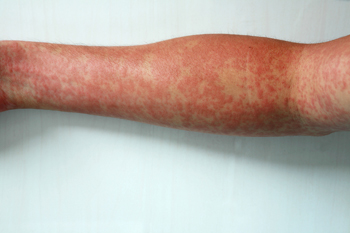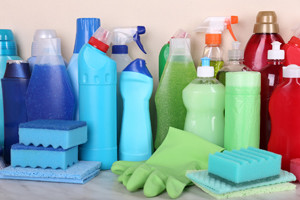By dermatology specialist Dr. Joshua Fox
Just as temperatures rise and you’re ready to don warm-weather clothes again, bam! You come down with a nasty red rash. But are you having an allergic reaction or is your skin just irritated? Contact dermatitis – which can be triggered by either allergens or skin irritants – is likely to blame.
Contact dermatitis is the medical name for rashes caused by culprits ranging from soaps, cosmetics, fragrances, jewelry, or plants such as poison ivy or poison oak. Some jobs also expose us to substances that can cause contact dermatitis.
The red, itchy rash of contact dermatitis isn’t contagious or life threatening, but it sure can be uncomfortable and unsightly. Many people get these sorts of rashes from time to time. It’s important to know that a variety of home treatments and medical approaches can be used to quickly and effectively tackle contact dermatitis. It is also possible now, through new testing, to find the etiology of what caused the contact dermatitis and how to safely avoid it in the future.
Many possible causes
Contact dermatitis may seem perplexing because rashes can be triggered by an exhaustive list of substances. There are two main types of contact dermatitis, irritant dermatitis and allergen dermatitis. Irritant dermatitis, the most common type, can be caused by:
- Soaps, fabric softeners, and detergents
- Hair dyes and shampoos
- Cement
- Pesticides or weed killers
- Rubber or latex gloves
- Solvents or chemicals
Allergic dermatitis, on the other hand, does not occur the first time you’re exposed to a substance – the reaction usually only happens after subsequent exposure. This form of contact dermatitis can be caused by:
- Adhesives, including those used for fake eyelashes or toupees
- Antibiotics rubbed on the skin surface, such as neomycin, bacitracin or polysporin.
- Fabrics and clothing
- Fragrances in perfumes, cosmetics, soaps and moisturizers
- Nickel or other metals that are found in jewelry, buttons, bra straps and zippers
- Poison ivy, poison oak, poison sumac and other plants
- Rubber or latex gloves
Additionally, some products cause contact dermatitis only after the skin is also exposed to sunlight, including shaving lotions, sunscreens, coal tar products, some perfumes, and even oil from the skin of a lime.
It is not always easy to tell if your rash was caused by an allergy or by an irritant because some of the symptoms may be identical. But an allergy usually provokes symptoms on or near the skin you touched the allergen with, while a rash from skin irritants may be more widespread.
Also, with an allergy, it may be a day or two before the rash shows up. But with an irritant, the rash usually shows up immediately, and it tends to be more painful than itchy.
Home treatments, medications can help

- Washing affected skin with water to remove any traces of remaining irritant
- Using anti-itch creams such as calamine lotion or corticosteroid skin creams or ointments
If your rash doesn’t get better after a few days, it’s time to call your dermatologist, who may – for patients with long-term, repeated contact dermatitis – perform allergy testing with skin patches. So-called “patch testing” can determine which allergen is causing the reaction. We have hundreds of test so we can discover the correct allergens. The American Contact Dermatitis Association, of which I am a member, will tell us, through an agreement with multiple manufacturers, which products the patient should avoid as well as which products can be safely used with their specific allergy.
Clinicians may also prescribe heavy-strength ointments, creams, or even pills to treat more severe cases of contact dermatitis.
While sometimes treatment may be necessary, if it is painful or uncomfortable and you are losing sleep or are distracted from your everyday life, it’s time to get your rash checked professionally. There’s no point in suffering in silence when treatment is so readily available. Failure to treat can lead to skin infection and scarring.

Joshua L. Fox, M.D., F.A.A.D., is the founder and medical director at Advanced Dermatology P.C.


